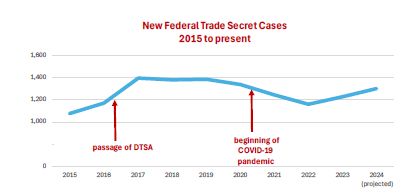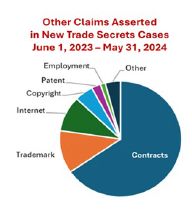WilmerHale lawyers advise clients on every aspect of trade secret law, from contracts to complex litigation. Below is our second annual update on trade secrets.1 It includes (1) a summary of the latest trends in trade secret filings, (2) recent significant trade secret cases and decisions, and (3) the notable policy developments of the past year.
Trends in Trade Secret Case Filings
The Post-DTSA Era Shows a Significant Increase in Federal Trade Secret Litigation
On May 11, 2024, the Defend Trade Secrets Act (DTSA) celebrated its eight-year anniversary. The DTSA's enactment in 2016 marked a turning point in US trade secret protection. It gave parties seeking redress for misappropriation a choice between commencing an action in federal or commencing it in state court, even in the absence of diversity jurisdiction.
Since the DTSA became law, the number of trade secret cases filed in district court each year has consistently remained above pre-DTSA levels. In 2015 (i.e., pre-DTSA), 1,075 trade secret cases were filed in federal district court. The following year, with the enactment of the DTSA in May 2016, that number ticked up to 1,168. But by 2017, the number had increased 30% to 1,394 (the current high-water mark) from pre-DTSA numbers. The number of federal trade secret cases remained stable from 2017 through 2020 before declining in 2021 and hitting a post-DTSA low of 1,158 in 2022. Last year, the figure rebounded, with 1,227 trade secret cases filed in district court.

As of the publishing of this alert, 2024 is on track to see that number grow further to just over 1,300 cases. This forecast is likely conservative in view of the Federal Trade Commission's recent nationwide ban on non-competes (see more on that in the policy discussion below). The number of trade secret case filings could easily surpass this forecast as companies increasingly turn to trade secret claims for protection, rather than other IP or contract claims.
The most popular venues for commencing trade secret litigation are the Central District of California (C.D. Cal.), Southern District of New York (S.D.N.Y.) and Northern District of Illinois (N.D. Ill.)—each accounting for at least 5% of federal trade secret complaints filed between May 11, 2016 (i.e., the DTSA's enactment) and the present. In the past 12 months, this trend has remained consistent with S.D.N.Y., C.D. Cal. and N.D. Ill. comprising the top three venues and combining for over 15% of DTSA complaints filed.2

Trade Secret Misappropriation Claims Are Often Accompanied by Other Claims
Recent statistics on federal case filings show that claims of trade secret misappropriation are commonly accompanied by other claims. For example, the circumstances giving rise to trade secret misappropriation claims often involve breach of contract allegations where the contract involved is an employment agreement, license or other partnership contract. Other companion claims frequently include patent, copyright and trademark claims, as demonstrated by the adjacent summary of accompanying claims asserted in trade secret cases over the past year.
Trade Secret Damages Remain Variable With Upper Bound Increasing
In May 2016, days after the DTSA was enacted, a Massachusetts jury in CardiAQ Valve Technologies, Inc. v. Neovasc Inc. et al., No. 1:14-cv-12405-ADB (D. Mass.), awarded CardiAQ $70 million in damages—later enhanced to $91 million—for Neovasc's misappropriation of six trade secrets related to CardiAQ's transcatheter mitral heart valve design. The $91 million in damages—the largest trade secret damages award in 2016—was awarded pursuant to Massachusetts trade secret law and common law, not the newly enacted DTSA. Accordingly, this damages award serves as a useful benchmark in comparing trade secret damages awards for the pre- and post-DTSA era.
Early damages awards resulting from DTSA claims were relatively modest sums. In 2017, the largest DTSA damages award was $500,000, awarded by a jury in Dalmatia Import Group, Inc. v. Foodmatch, Inc. et al., No. 2:16-cv-02767 (E.D. Pa.). Comparatively, the largest award relying on state and common trade secret law that same year was $10 million, awarded in Wal-Mart Stores, Inc. v. Cuker Interactive, LLC, No. 5:14-cv-05262 (W.D. Ark.).
In 2024, the trend of sizable damages awards resulting from DTSA claims has continued. In January, $71.2 million was awarded to material solutions provider Trinseo for theft of its trade secrets related to polycarbonate manufacturing, including design drawings of manufacturing plants, process flow diagrams and equipment specifications. See Trinseo, S.A. v. Harper et al., No. 4:20-cv-00478 (S.D. Tex.). More recently, in May, North Carolina–based connectivity and power solutions provider Qorvo was awarded $31 million in compensatory damages and an additional $7 million in exemplary damages for Akoustics, Inc.'s misappropriation of Qorvo's trade secrets related to its bulk acoustic wave resonator filters, key components for accomplishing radio frequency filtering for wireless devices. See Qorvo, Inc. v. Akoustis Technologies, Inc. et al, No. 1:21-cv-01417 (Del.).
Notably, even in the absence of an accompanying DTSA claim, trade secret claims based on state and common law continue to result in large damages awards. On May 30, 2024, a federal jury in Zunum Aero Inc. v. The Boeing Company et al., No. 2:21-cv-00896 (W.D. Wash.), awarded Zunum Aero—an electric aircraft startup—over $81 million in trade secret damages and $11.5 million for tortious interference (then jointly reduced by $20.82 million for failure to mitigate) for Boeing's misappropriation of trade secrets related to hybrid-electric and all-electric aircraft technology (discussed in more detail below).
In the past few years, the Federal Circuit has vacated several large damages awards in patent cases due to methodological flaws that resulted in overvaluing the technology at issue. See, e.g., Apple Inc. v. Wi-LAN Inc., 25 F.4th 960 (Fed. Cir. 2022), and California Inst. of Tech. v. Broadcom Ltd., 25 F.4th 976 (Fed. Cir. 2022) (vacating awards of $85.2 million and $1.1 billion, respectively). Trade secret defendants may find similar success in pressing courts for rulings that reject a plaintiff's damages theories and require plaintiff to appropriately tailor the demand to the value of the misappropriated trade secrets.
To view the full article please click here.
Footnotes
1 To read last year's update, please visit WilmerHale's Insights & Events page to access 2023 Trade Secret Update: A Look Back at Recent Trade Secret Developments, published June 12, 2023.
2 Notably, the International Trade Commission (ITC) instituted only two investigations of trade secret misappropriation claims in 2023. This is down from six investigations in 2022 and a further decline from a height of nine ITC trade secret investigations in 2021. As of the publication date for this alert, the ITC has not instituted any investigation in 2024 alleging trade secret misappropriation. See www.usitc.gov/intellectual_property/337_statistics_types_unfair_acts_alleged_active.htm.
The content of this article is intended to provide a general guide to the subject matter. Specialist advice should be sought about your specific circumstances.





